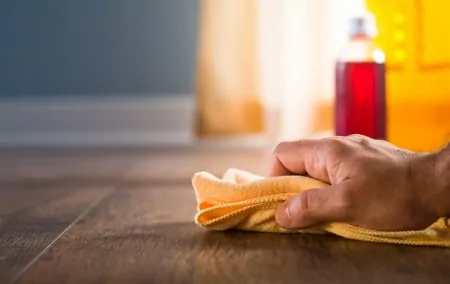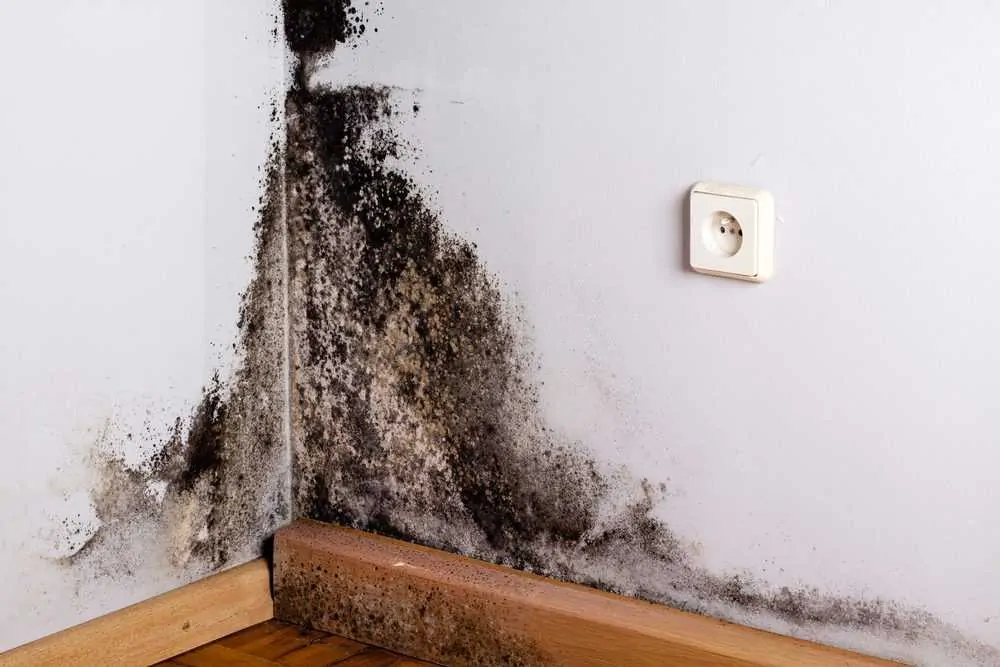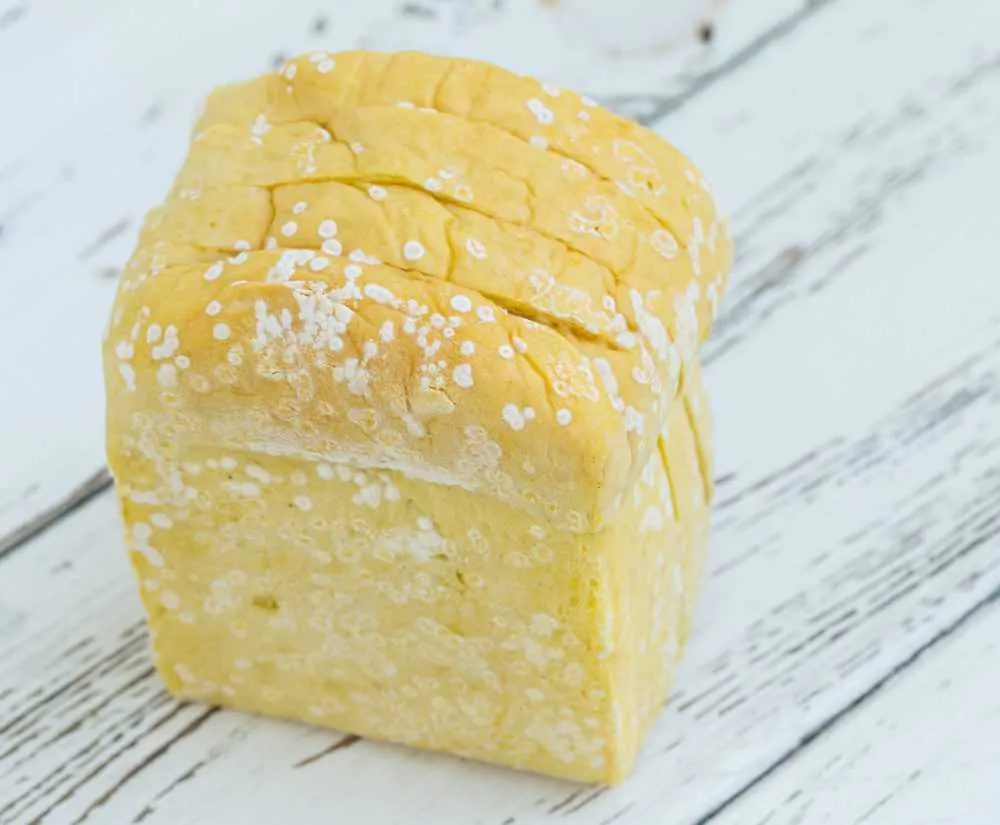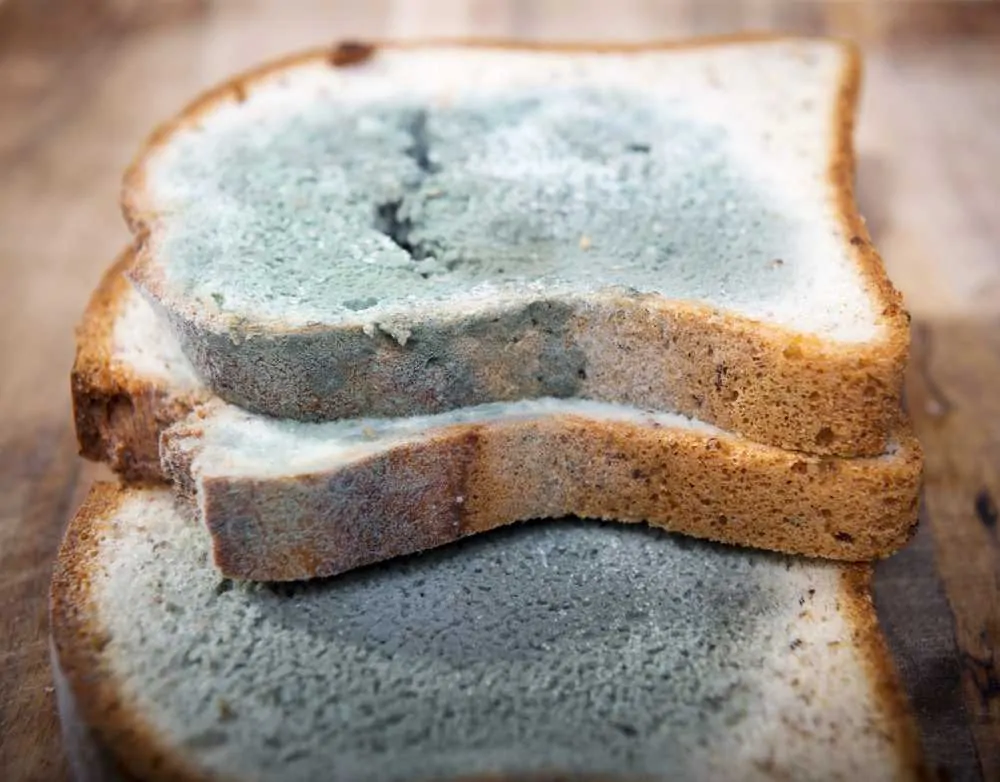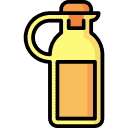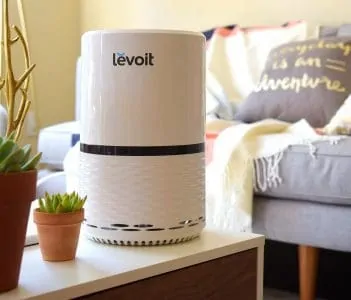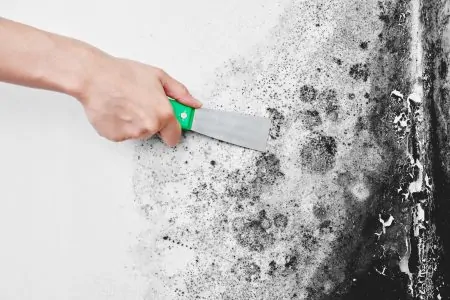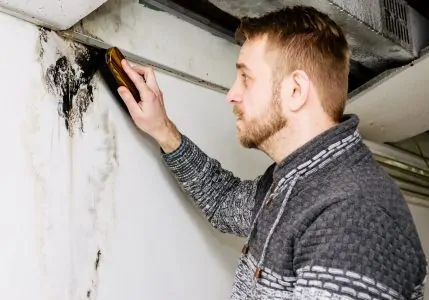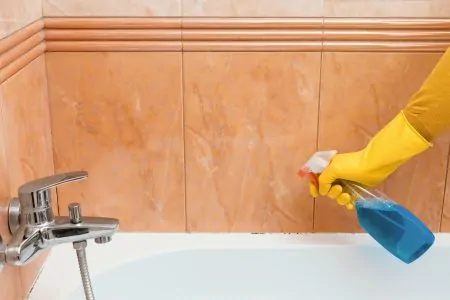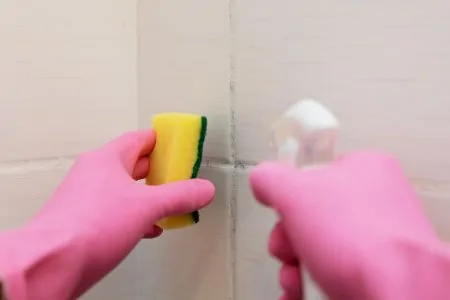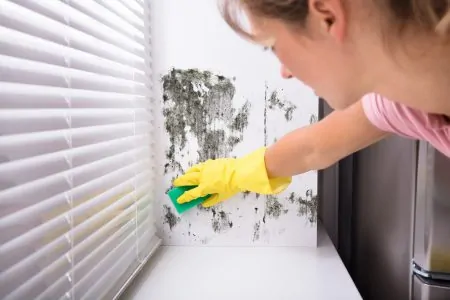Mold infestations on wood within your home are unsightly and, even worse, hazardous to your health. The mold on your furniture, floors, or decking can potentially destroy the wood.
It’s imperative to take action as soon as you notice any signs of mold. Once the wood is mold-free, take preventative measures to protect it from mold in the future.
Wood is porous, so it can be challenging to remove the mold. But you can use a range of effective products and techniques to kill it. We’ll walk through a step-by-step for how to remove mold from wood.
Key Takeaways
- Mold on wood can be harmful to your health and damage the wood’s structure; identifying and treating it is essential.
- Black mold (Stachybotrys chartarum) is the most dangerous type, while white and green molds can also cause problems.
- Remove mold from wood using natural solutions like distilled white vinegar, hydrogen peroxide, or borax, or use commercial mold cleaners.
- Prevent mold growth by controlling humidity, drying wet areas quickly, and fixing water leaks.
How to Identify Mold on Wood
Wood is notorious for mold growth as it easily absorbs water, making it a perfect environment for mold to grow (1). If you notice patches of black dots, green streaks, or white discoloration on your wood surfaces, this is mold growth. You’ll need to take action immediately.
Hundreds of species of mold are present in indoor and outdoor environments. While many mold species are safe, some can be hazardous to your health, especially if they grow inside your home (2).
Understanding the Different Types of Mold
The three most common types of mold can be identified by their color — black, white, and green.
Black Mold
Many types of mold are black and harmless. However, one of the most dangerous types of black mold is Stachybotrys chartarum.
Because it releases mycotoxins, exposure to this black mold can cause serious health issues. This includes respiratory problems, headaches, and more (3).
Black mold needs more moisture than other types of mold in order to grow. As a result, it’s more likely to be found in damp places or in areas where there’s been a flood or water leak (4).
Unfortunately, this type of mold has deeper roots than the other types of mold. Naturally, this makes it harder to get rid of, especially if it has infested porous surfaces like wood.
White Mold
White mold has a powdery, stringy appearance and is not toxic. However, a moldy environment within the home can still cause health issues for you and your family.
White mold grows on organic materials, such as wood, fabric, food, and carpet. Mold growth on a wooden structure can cause rot and destroy it if not dealt with.
Green Mold
The term “green mold” applies to various species and usually has a soft and fuzzy texture. This type of mold grows on spoiled food like bread and fruit. You’ll also find it in areas of your home with a water problem.
Green mold can be harmful. Although not quite as dangerous as black mold, it can still cause medical problems. So you should ensure that you get rid of it as soon as you see any signs of growth.
Products for Removing Mold From Wood
There are numerous ways to get rid of mold from wood. You can either use eco-friendly and natural products or chemical products.
Different products are suitable for different types of wood. It depends on whether the wood has been painted or stained, making it non-porous, or if it’s unpainted and unstained, making it porous.
On non-porous wood, mold remains on the surface, but if on porous wood, then the roots will be within the wood.
- Vodka: This may surprise you, but vodka is highly effective at killing mold on painted or stained wood. Plus, it disinfects the surface too.
- Borax: This white household powder is only effective on treated, non-porous wood. It kills mold and prevents new growth. However, always mix it with water. Otherwise, it could damage porous wood and make the problem worse.
- Distilled white vinegar: Vinegar can remove mold on most wood surfaces. It will penetrate the wood and kill the mold at the roots.
- Dishwashing detergent: Liquid dishwashing detergent mixed with warm water effectively kills mold on painted or stained wood.
- Hydrogen peroxide: Hydrogen peroxide has antifungal, antiviral, and antibacterial properties, making it highly effective at killing mold on porous surfaces such as wood (5).
- Mold Armor: This fast-acting and powerful solution kills mold and forms a protective seal that prevents it from growing back.
- Siamons International Mold Control: This safe and effective spray can be used on wood furniture, a composite wood deck, and any other type of wood in your home that may be affected by mold. It kills mold and eliminates moisture, which helps to prevent mold from growing back.
- Sporicidin Mold Stain Cleaner: This is a highly concentrated and powerful formula for treating mold on wood.
Stay Away From Bleach
How to Remove Mold from Wood Furniture
If you’re dealing with light mold on wooden furniture that has been painted or stained, likely, the mold is only on the surface. You can remove it by placing the furniture in direct sunlight. You may also clean it with distilled white vinegar, dish detergent, borax, or vodka.
But, to remove mold from wood, begin by vacuuming loose spores with the soft brush attachment. Then use one of the methods below:
Sunlight
An effective way to remove light mold and musty odors from wooden furniture is to place it outside in direct sunlight. Mold spores thrive where there is moisture, high humidity, and darkness. Therefore, sunlight and fresh air is a powerful way to kill mold spores.
Take the furniture outdoors early in the morning and bring it back inside before sunset. You can repeat this for another day or two if necessary. Remember to check the weather forecast to ensure your furniture doesn’t get soaked in a downpour.
For even better results, lightly spray the furniture with a solution of distilled white vinegar and water in the morning when you place it outside.
Dishwashing Detergent
Mix a generous squirt of dish detergent in a bucket of warm water. Using a soft bristle brush, gently scrub the affected area.
When you have finished cleaning, wipe the surface with a damp cloth to rinse it. If the mold has been removed, you can wipe the surface with a dry rag. But if there’s still mold on the furniture, you’ll need to repeat the process.
Vinegar
Add distilled white vinegar to a spray bottle and spritz the furniture thoroughly. Leave it for an hour, then wipe the surface with a clean damp cloth.
Vodka
Fill a spray bottle with cheap vodka (don’t waste the good stuff) and apply it to the affected surface. Leave for approximately 10 minutes, then scrub away the mold using a sponge.
Ideally, you should move the furniture outside to dry in direct sunlight or open windows to ventilate the room. This will help the wooden furniture dry as quickly as possible.
Borax
Mix one cup of borax with a gallon of water in a bucket. Apply the solution using a rag and scrub until the mold is gone.
Next, wipe the furniture with a clean cloth to remove any excess solution. Leave the furniture to dry, ideally in the sun. Once the wood is completely dry, you can apply a few drops of linseed oil to a clean linen cloth and wipe the surface.
Removing Mold from Wood Floors and Ceilings
If you have surface mold on your wood floor or ceiling, your first step is to identify the mold’s source. This means you’ll need to look for any signs of water damage (such as leaks) that may have caused the mold.
- Time: 20-30 minutes.
- Difficulty: Easy.
What You’ll Need
- Spray bottle.
- Distilled white vinegar.
- Dish soap.
- Water.
- Cloths.
- Hydrogen peroxide or commercial mold cleaner (optional).
- Hard bristle brush (optional).
- Protective equipment, such as mask and gloves.
1. Clear Furniture
Clear away any furniture in the room. This helps to expose the entire area that has been affected by mold.
2. Make and Spray the Solution
Next, prepare a spray bottle of vinegar, dishwashing soap, and water. Spray on the affected area, allow it to sit for 10 minutes, and wipe with a cloth. This will kill any live mold before it spreads.
3. Rinse Area
Wipe the area with a clean, wet cloth to remove any solution once the mold is gone.
4. Dry and Rearrange Room
Once the floor has completely dried, you can put furniture back in place. However, we recommend you check the area over the next few weeks to ensure the mold has not returned.
5. If the Problem Persists
If the mold has penetrated the wood floor or ceiling, you can try using either hydrogen peroxide or a professional chemical solution. Apply to the affected wood and let the solution soak in for a few minutes, then use a hard bristle brush and scrub the mold.
Protect Yourself
How to Get Rid of Mold on Wood Decks
Wood decks are particularly prone to mold as they are outdoors and exposed to the elements.
- Time:
- Difficulty:
What You’ll Need
- Laundry detergent.
- Water.
- Bucket.
- Hard-bristled brush.
- Deck cleaner with oxygen bleach (optional).
- Protective coating (optional).
1. Make Cleaning Solution
The most effective way to eliminate mold on your decks is to mix one-third of a cup of laundry detergent per gallon of water.
2. Scrub the Deck
Dip a stiff brush into the solution and scrub the deck.
3. Tackle Stains
If the wood is stained from the mold, you may have to do more. Use a specialized deck cleaner containing oxygen bleach to help remove any markings.
4. Protect the Deck
After you have removed the mold, applying a protective coat to your deck is advisable to prevent mold in the future.
Tips for Preventing Mold on Wood
You can help prevent mold from affecting wood in your home by taking proactive measures. Sadly, if the mold has penetrated too far into the wood, it’s most likely damaged and will need replacing.
The most effective way to prevent mold from growing on wood is to dry the wood surface. To do this, you must dry wet areas as soon as possible. It’s also crucial to control your home’s humidity and moisture levels. Keep humidity under 60 percent (6).
You can minimize the humidity by using a dehumidifier to remove moisture from the air. Open the windows as often as possible to ventilate the rooms and allow fresh air to circulate.
FAQs
Breaking the Mold
It’s essential to look out for signs of mold on your wood surfaces. You’ll need to take steps to get rid of it as soon as it begins to grow — before it spreads too much and becomes a severe issue.
If you need to know how to remove mold from wood, our steps and tips can help. Various natural and chemical treatments kill mold and prevent future mold growth.
However, prevention trumps cure. So, taking measures to prevent damp conditions in your home and ensuring you fix any water leaks quickly are the best solutions for stopping mold growth on wood.
